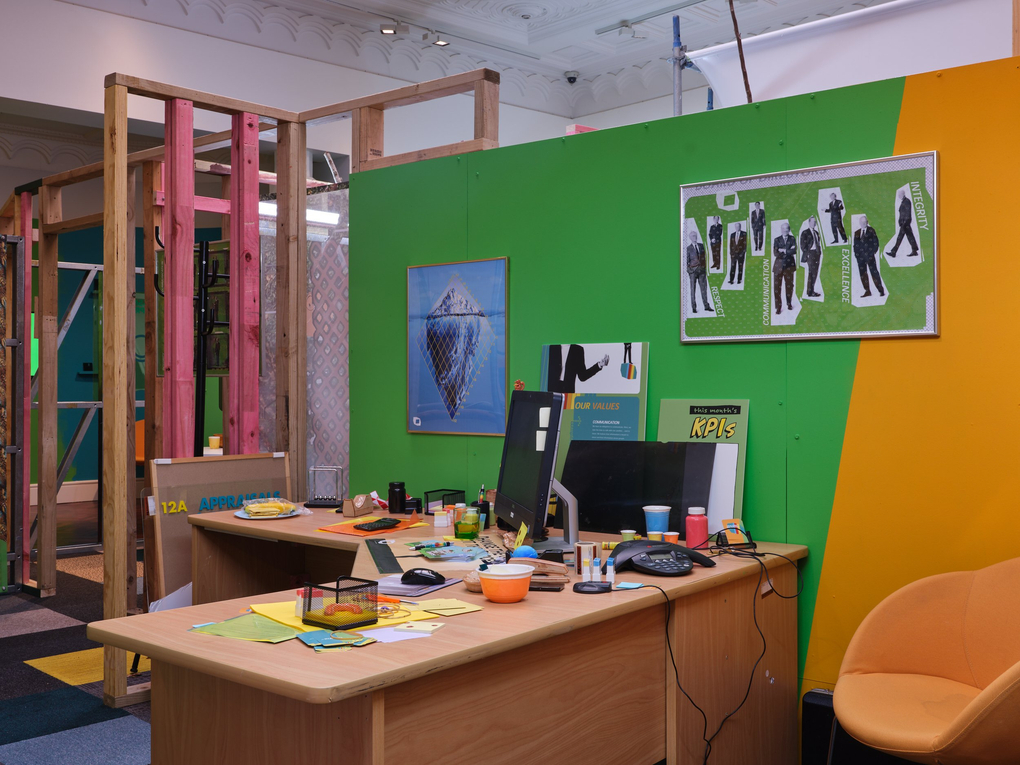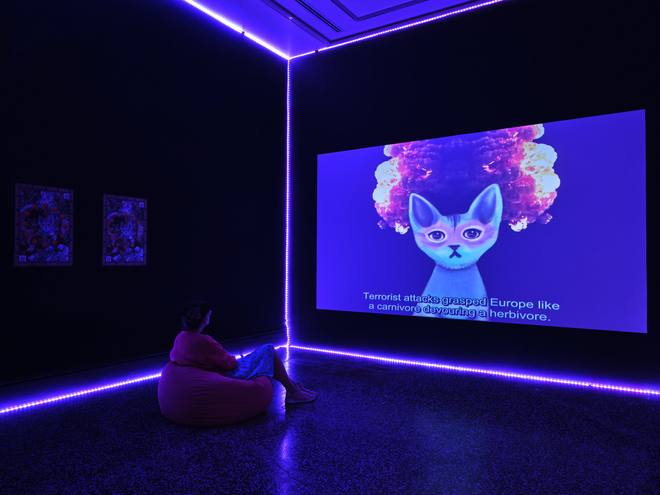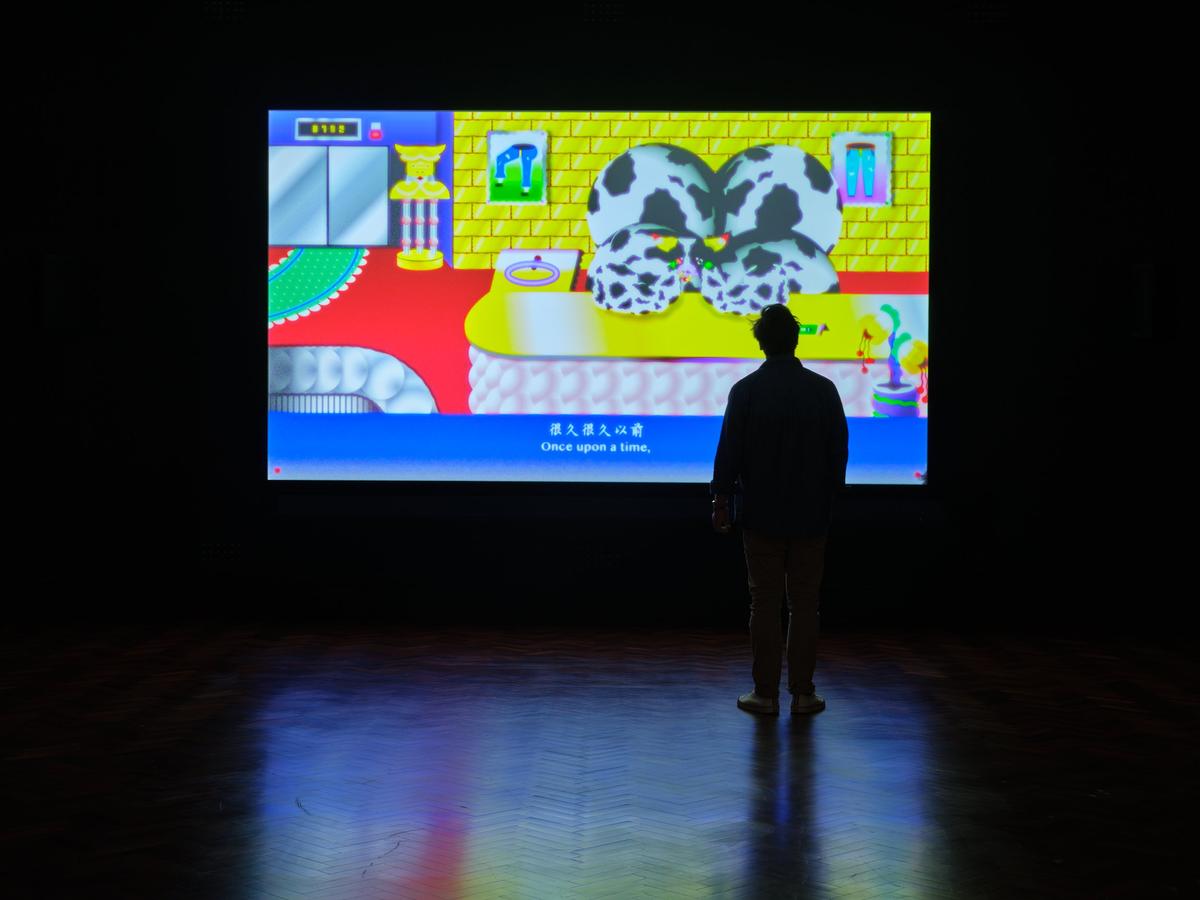happiness is only real when shared is a follow up to We’re Not Too Big To Care, the inaugural exhibition curated by Lisa Beauchamp when she first took the reins of Gus Fisher Gallery in 2019. In the barely two years that have passed between these exhibitions, the world has been altered to such a degree that "business as usual" is a state that we can barely hope to return to.
In We’re Not Too Big To Care Beauchamp took aim at the effects of late-capitalism by asking after the sustainability of interpersonal relationships in an increasingly globalised world. Likewise, the show considered the gallery’s own role within Tāmaki’s business district. Fast-forward to 2021, and we find ourselves reeling from the global fallout of natural disasters, social upheavals, political failures and the largest global pandemic to occur in a generation. Closer to home, happiness is only real when shared opened just as Tāmaki emerged from its second COVID lockdown.
Presenting works by three contemporary artists from Aotearoa, Hong Kong and Turkey/USA, happiness is only real when shared addresses the current moment by imagining alternative realities, both absurd and frighteningly prophetic in scope.
Walking into the gallery foyer, visitors must negotiate a labyrinthine office staged using scaffolds, construction wrap and prefab walls. Strewn brochures and posters let us know that we have entered The Bureau of Happiness, a fictional recruitment consultancy devised by Mark Schroder promising to procure “the specialist talent your company needs.” This is Fortune Teller (2021), a new, large-scale commission by the artist.

Installation view of Fortune Teller (2021) Mark Schroder. Courtesy of the artist. Photography by Sam Hartnett. Image courtesy of Gus Fisher Gallery, happiness is only real when shared (2021)
Those familiar with Schroder’s works will recognise the montage of homogenous office furniture and corporate neologisms of his earlier installations. At each turn, posters and PowerPoints offer up bewildering mission statements and redundant affirmations. One attempts to explain what the Bureau can achieve, using manufacturing and financial shorthand mixed with new-age tautologies now common amongst large organisations. The Bureau of Happiness will “create a purpose-driven work environment to give your employees a chance to contribute to a greater purpose” while insisting “happiness is subjective wellbeing.”
However, Schroder’s work is also filled with a wry, post-apocalyptic comedy. Bookshelves are lined with concrete bricks and sticky-notes masquerade as cheese slices. The only viable ‘nutrients’ in this environment have been replaced by ceramics; bananas, bottles of vitamins, instant ramen bowls and XL cans of V. Lights and monitors remain on, dead leaves have blown through, and desks are strewn with all the detritus of a busy workplace interrupted, perhaps due to an emergency evacuation, zombie invasion or viral outbreak, the latter being a real scenario as white-collar workers have abandoned the city centre in favour of WFH (work from home) situations (this lack of human occupation will become a recurring theme in this exhibition).
Schroder, an artist who moonlights as a financial services lawyer (or vice-versa), here presents us with a case study in corporate existential neuroses. Yet the disappearance of individuality or the self under corporate capitalism isn’t a new idea—it’s been explored within art for at least a century. Schroder’s practice—which looks at boom and bust economic cycles—here focuses on the pandemic-era demise of white-collar workers, hinting at new and insidious ways in which work-from-home employers are profiting by offloading costs onto employees, including office space rental, equipment and overtime. While all of this is true, it’s also hard to feel empathy for these workers who have borne so much less financial and physical risk than front line workers. In this sense, Fortune Teller feels a little out of step with the present, naively side-stepping the question of class in order to parody an abstracted entity that is hardly defensible to begin with.
Excerpt: Mark Schroder, Fortune Teller (2021). Courtesy of the artist and Gus Fisher Gallery
Two video works in the show by Hong Kong artist Wong Ping fill the largest gallery. Presented as large projections, Fables 1 (2018) and Fables 2 (2019) take the form of five contemporary fairy tales. An overachieving chicken sets out to reform the police force, and a socialist cow becomes the CEO of a distressed jeans factory. Other fables follow conjoined triplet rabbits as they betray one another in an attempt to escape their poverty-stricken circumstances; a tree who navigates moral dilemmas on public transport; and the romantic miscommunications of a turtle and a mono-lidded elephant. Animated in Wong’s characteristically hallucinatory style (reminiscent of early video games and Windows operating systems), these stories are contemporary takes on Aesop’s fables and the brothers Grimm, coloured with the seedy morals of a transactional, cosmopolitan cityscape.
With scathing wit and black humour, Fables teeter on edge of impropriety. As the text-to-voice female narrator quips, “there’s always a challenging struggle between curiosity and fear, as if coming across a nude photo of a family member that was leaked onto the internet.” Wong’s Fables extrapolate worse-case scenarios, granting his characters nefarious desires or social anxieties too sensitive to talk about without the distancing effects of animation. Removed from reality, viewers are granted the permission to jeer at Turtle’s salacious opportunism and Chicken’s misfortune when he accidentally massacres his family and colleagues. Wong balances this sense of curiosity and fear well, often transforming real-life happenings into scripts for his animations (Tree’s story was inspired by a bus journey Wong took where he encountered a cockroach—one of his phobias—crawling up the arm of a pregnant woman).
Trailer: Wong Ping, Wong Ping's Fables (2018) Courtesy of the artist and Gus Fisher Gallery
At each plot twist, Fables draws the viewer deeper and deeper into socioeconomic and geopolitical mire of the artist’s native Hong Kong. Cow’s early revolutionary spirit is crushed when he accidentally gores an officer, leading to his repeated humiliations in prison. His success in life is never considered in its totality, instead he is judged by an arbitrary scale, its measures so incidental that it is heartbreaking to watch. These fables subtly express the diminished autonomy and opportunities open to Hong Kong’s youth whilst recognising the external forces that animate our interpersonal relationships.
A self-trained artist, Wong uses Illustrator to create his vector animations, refining a DIY narrative style that perfectly suits the macabre, deadpan delivery. Each fable ends with a moral, presented like a talisman or fortune, and it is through Cow’s story that the exhibition gains its title. But these morals are infused with a sense of perversion, saccharine in the face of tragedy and laced with cynicism.
The third and final work in the exhibition considers just what might happen if we were to forfeit part of our collective political imagination. The Kitty AI: Artificial Intelligence for Governance (2016) by Turkish-American artist and architect Pinar Yoldas, is a video that imagines a near future where artificial intelligence has begun to replace humans as politicians. Thus, The Kitty AI is the first governor of the world, programmed to manage the gigantic infrastructures that humans have proven themselves incapable of. It takes the form of a blue kitten located within individuals’ smartphones, at once accessible and deceptively pervasive.

Installation view of The Kitty AI: Artificial Intelligence for Governance (2016) Pinar Yoldas. Courtesy the artist. Photography by Sam Hartnett. Image courtesy of Gus Fisher Gallery, happiness is only real when shared (2021)
Given recent events, The Kitty AI feels prophetic, both a frightening thought experiment and logical consequence of our failures. But The Kitty AI’s childish voice and cute visage belies her intent. “Politics [has] been a time sink and the biggest distraction. What if politicians were out of the picture… [and] replaced by love?” This seems too simplistic a solution, replacing political struggle with emotion. Amongst a backdrop of found imagery and animal videos are references to the European Union, suggesting that this is not a benign PSA but a form of propaganda. A poster featuring dozens of collaged kittens next to the video provides the imperative to "VOTE". An embedded QR code leads us to a Twitter account that reads like political spin. With The Kitty AI, Yoldas asks; Would AI bring about the demise of humans or can it enhance our lives? With the recent political turmoil amidst the western world, Yoldas’ proposition is tempting.
happiness is only real when shared raises multitudes of issues imagining our current feelings of alienation and futility through to future heightened scenarios. There’s a sharpness to the exhibition that feels less optimistic and more cynical and wary than the inaugural show, We’re Not Too Big To Care. Yet, in attempting to speak to the current moment, happiness is only real when shared wades into dangerous territory by speaking too broadly. While the exhibition presents a sense of the collective imaginary and its emancipating force, by adopting one of Wong’s aphorisms, the show becomes rather contradictory and sardonic, which might leave viewers feeling cold or disillusioned. Throughout, the lack of human presence is noticeable, allowing a disembodied feeling to pervade, most noticeably in Yoldas’ work where The Kitty AI attempts to convey human emotion through programmatic speech. Herein lies the show’s Achilles heel. If viewers will struggle to empathise with the works, they are forced to accept the works at face value—as simply ironic.
